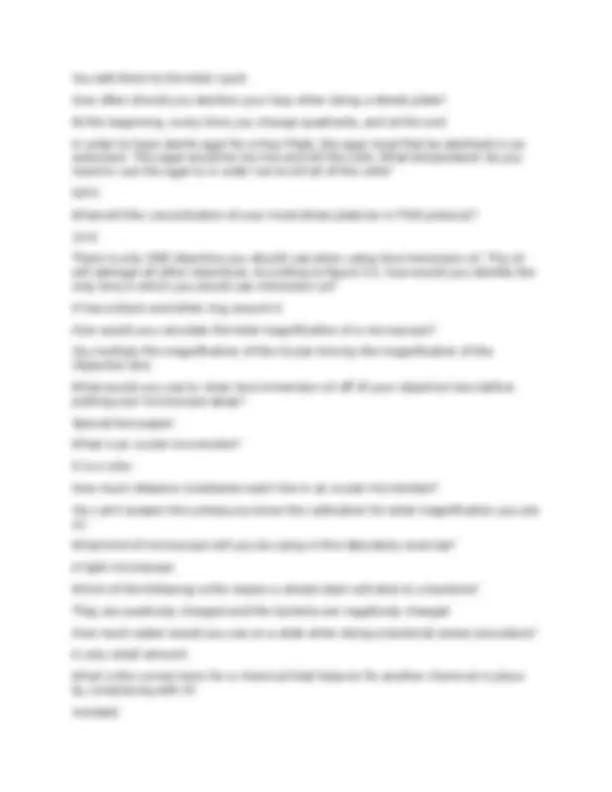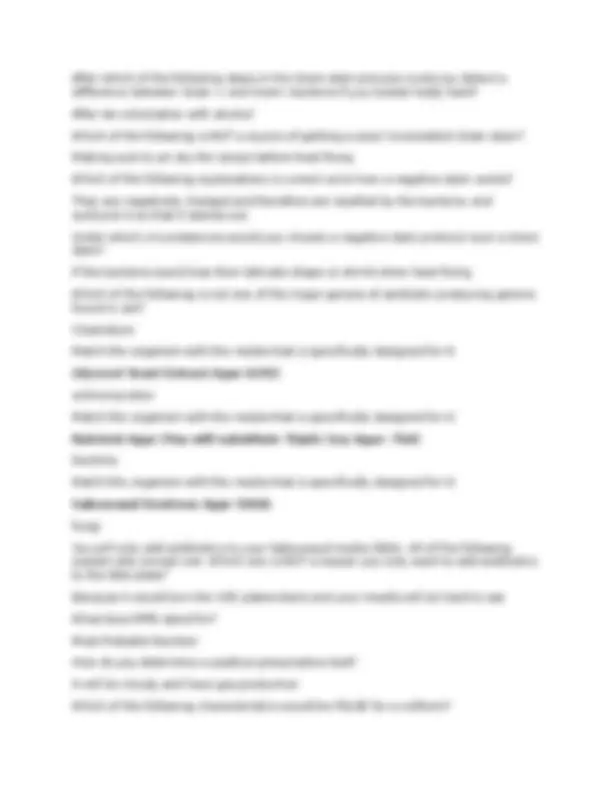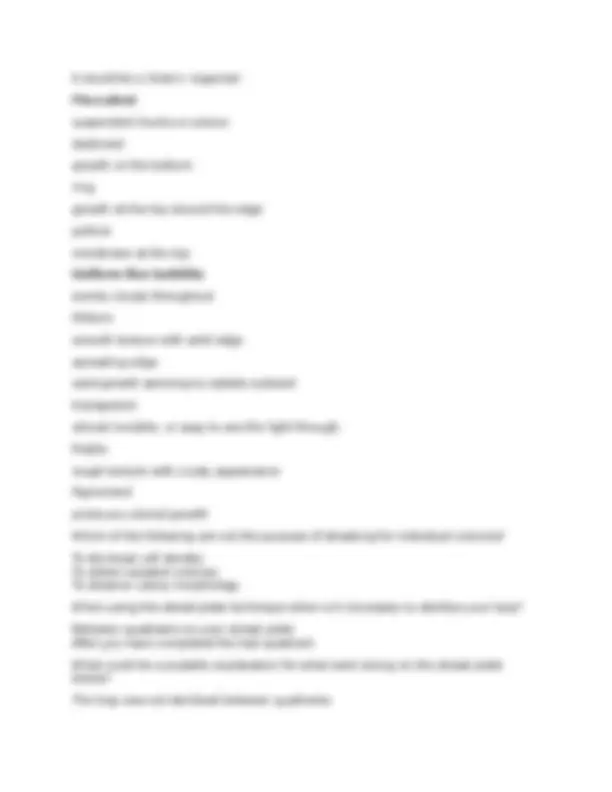





Study with the several resources on Docsity

Earn points by helping other students or get them with a premium plan


Prepare for your exams
Study with the several resources on Docsity

Earn points to download
Earn points by helping other students or get them with a premium plan
Community
Ask the community for help and clear up your study doubts
Discover the best universities in your country according to Docsity users
Free resources
Download our free guides on studying techniques, anxiety management strategies, and thesis advice from Docsity tutors
A comprehensive set of multiple choice questions and answers covering various aspects of microbiology laboratory techniques. It covers topics such as culture transfer, streak plate method, gram staining, and media types. Designed to help students prepare for their first microbiology lab exam.
Typology: Exercises
1 / 6

This page cannot be seen from the preview
Don't miss anything!




Lab exam 1 Where would you expect to find a saprophyte organism? In soil Which of the following things below would result in a pure culture? A completely isolated colony growing on a plate Microorganims are ubiquitous. This means they would be found in which of the following places? Soil The body On an aluminum railing Some bacteria can lyse (break down) red blood cells in a process called hemolysis. Match the following descriptions of hemolysis with the correct outcome on a blood agar plate: α hemolysis There will be a greenish colored zone around the bacterial growth due to incomplete lysis of the red blood cells Some bacteria can lyse (break down) red blood cells in a process called hemolysis. Match the following descriptions of hemolysis with the correct outcome on a blood agar plate: β hemolysis The blood agar plate will show clear around the bacterial growth due to complete hemolysis of the red blood cells Some bacteria can lyse (break down) red blood cells in a process called hemolysis. Match the following descriptions of hemolysis with the correct outcome on a blood agar plate: ϒ hemolysis the blood agar plate will show no hemolysis Which of the following things is a safe practice when transferring cultures? Hold the inoculating loop like a pencil The handles of inoculating loops can get very hot. How hot can your inoculating loop get if you leave it in the incinerator for a really long time? close to 800* When a cap is removed from a tube in the transfer process, where does that cap go?
It is held by the pinky finger of your loop hand What is the appropriate time to flame your inoculating loop when transferring your culture Both before and after you transfer the bacteria In your epi-tubes you are transferring continually more dilute samples from tube to tube. According to your spread plate protocol, which of the following represents the order of tubes from most concentrated to most dilute? Tube order: A,B,C,D Which of the following morphology terms would describe a tiny pinpoint colony? punctiform Match the media type below with its intended purpose? Plates used to isolate species Match the media type below with its intended purpose? Agar slants used when you want to grow a culture to store in the refrigerator Match the media type below with its intended purpose? Broths used to grow cultures Which of the following is the correct location to label a tube and a plate? Tubes are labeled on the glass and plates are labeled on the bottom Though all of the following things are true, according to your lab manual,which of the things below is the MAIN reason you never set a test tube on the counter, but place it in a rack instead? To prevent the test tube from leaking What does CFU stand for? Colony forming units The purpose of the streak plate method is to isolate individual colonies. Which of the following things is NOT true about the streak plate method? Your most isolated colonies should appear in quadrant 1 When counting cells on a Pour Plate, what do you do with the small colonies you can see embedded in the agar?
After which of the following steps in the Gram stain process could you detect a difference between Gram + and Gram- bacteria if you looked really hard? After de-colorization with alcohol Which of the following is NOT a source of getting a poor/ inconsistent Gram stain? Making sure to air dry the smear before heat fixing Which of the following explanations is correct as to how a negative stain works? They are negatively charged and therefore are repelled by the bacteria, and surround it so that it stands out. Under which circumstances would you choose a negative stain protocol over a Gram stain? If the bacteria would lose their delicate shape or shrink when heat fixing Which of the following is not one of the major genera of antibiotic producing genera found in soil? Clostridium Match the organism with the media that is specifically designed for it: Glycerol Yeast Extract Agar (GYE) actinomycetes Match the organism with the media that is specifically designed for it: Nutrient Agar (You will substitute Triptic Soy Agar- TSA) bacteria Match the organism with the media that is specifically designed for it: Sabouraud Dextrose Agar (SDA) fungi You will only add antibiotics to your Sabouraud media (SDA). All of the following explain why except one. Which one is NOT a reason you only want to add antibiotics to the SDA plate? Because it would turn the GYE plates black and your results will be hard to see What does MPN stand for? Most Probable Number How do you determine a positive presumptive test? It will be cloudy and have gas production Which of the following characteristics would be FALSE for a coliform?
It would be a Gram+ organism Flocculent suspended chunks or pieces Sediment growth on the bottom ring growth at the top around the edge pellicle membrane at the top Uniform fine turbitity evenly cloudy throughout Filiform smooth texture with solid edge spreading edge solid growth seeming to radiate outward transparent almost invisible, or easy to see the light through friable rough texture with crusty appearance Pigmented produces colored growth Which of the following are not the purpose of streaking for individual colonies? To decrease cell density To obtain isolated colonies To observe colony morphology When using the streak plate technique when is it necessary to sterilize your loop? Between quadrants on your streak plate After you have completed the last quadrant What could be a possible explanation for what went wrong on the streak plate below? The loop was not sterilized between quadrants